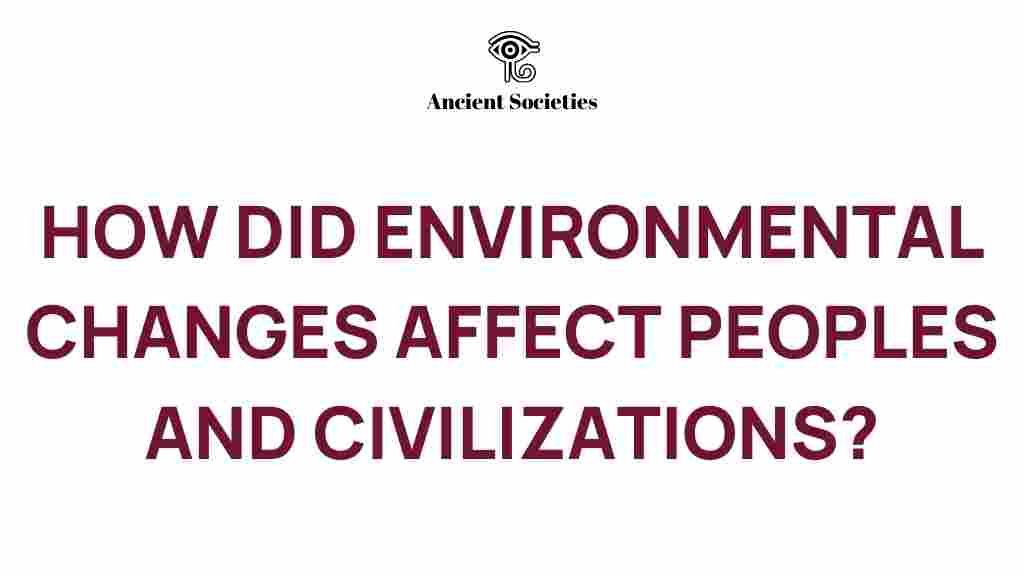Unraveling the Impact of Environmental Changes on Civilizations
Throughout history, civilizations have been shaped by a myriad of factors, but none have had such a profound impact as environmental changes. From climate shifts to ecological transformations, these changes have influenced the trajectory of human societies, compelling them to adapt, innovate, and sometimes even collapse. In this article, we will explore the intricate relationship between environmental changes and civilizations, focusing on climate impact, society evolution, historical adaptation, ecological shifts, cultural resilience, and the survival of ancient societies.
The Historical Context of Environmental Changes
Environmental changes have been a constant throughout Earth’s history, often acting as a catalyst for societal transformation. Ancient societies faced various challenges due to climate impact, including:
- Glacial Periods: Ice ages forced human populations to migrate, affecting settlement patterns.
- Desertification: Areas like the Sahel experienced ecological shifts that led to the decline of farming communities.
- Natural Disasters: Events such as earthquakes and volcanic eruptions devastated civilizations like the Minoans.
Understanding these historical adaptations provides a framework for analyzing how modern societies can respond to similar challenges.
The Role of Climate Impact on Societies
Climate impact is one of the most significant environmental changes affecting civilizations. Shifts in temperature and precipitation patterns can lead to:
- Resource Scarcity: Droughts and floods can limit food and water supplies, prompting migration and conflict.
- Economic Disruption: Agricultural economies are particularly vulnerable to climate variability, affecting trade and livelihoods.
- Health Risks: Changes in climate also influence disease patterns, impacting overall societal well-being.
For instance, the collapse of the Maya civilization in the 9th century is often attributed to prolonged droughts, which devastated their agriculture and led to societal unrest.
Society Evolution in Response to Environmental Changes
Societies have evolved in response to environmental changes through various strategies, including:
- Technological Innovation: The development of irrigation systems in ancient Mesopotamia allowed for more efficient farming despite changing rainfall patterns.
- Migration: Populations often moved to more hospitable areas when faced with ecological shifts, as seen with the movement of the Bantu people in Africa.
- Political Reorganization: Civilizations might reorganize their governance structures to better manage resources and respond to environmental pressures.
These adaptations demonstrate the resilience of societies in the face of adversity.
Case Studies: Historical Adaptation to Environmental Changes
To illustrate the impact of environmental changes on civilizations, we can examine several case studies:
The Ancient Egyptians
The Nile River was the lifeblood of ancient Egypt, and its annual flooding provided fertile soil for agriculture. However, fluctuations in the river’s flow due to climate changes led to:
- Famine: Insufficient flooding caused crop failures.
- Social Stratification: Resource scarcity exacerbated social inequalities, leading to unrest.
The Egyptians adapted by developing advanced irrigation techniques, showcasing cultural resilience in the face of environmental challenges.
The Ancestral Puebloans
In the American Southwest, the Ancestral Puebloans thrived until a series of prolonged droughts in the late 13th century forced them to abandon their cliff dwellings. Their adaptation strategies included:
- Crop Diversification: They began to cultivate drought-resistant crops.
- Migrating: Many moved to lower elevations with more reliable water sources.
This case exemplifies how ecological shifts can challenge civilizations to evolve or face collapse.
Cultural Resilience and Modern Implications
Cultural resilience is crucial for societies facing environmental changes today. As we confront global warming and ecological degradation, lessons from ancient societies can guide our responses. Key aspects of cultural resilience include:
- Community Engagement: Encouraging local participation in resource management fosters adaptability.
- Education and Awareness: Understanding historical adaptations equips societies to respond effectively to modern challenges.
- Innovation: Embracing new technologies can improve sustainability and resource efficiency.
By learning from the past, we can better prepare for the future.
Step-by-Step Process: Adapting to Environmental Changes
Here’s a step-by-step process that modern societies can adopt to effectively respond to environmental changes:
- Assess Vulnerabilities: Identify which aspects of society are most at risk from environmental changes.
- Engage Stakeholders: Involve community members, businesses, and government in discussions about adaptation strategies.
- Develop an Action Plan: Create a comprehensive plan that includes resource management, infrastructure improvements, and emergency response strategies.
- Implement Sustainable Practices: Promote sustainable agriculture, renewable energy, and conservation efforts.
- Monitor and Evaluate: Continually assess the effectiveness of adaptation strategies and make adjustments as necessary.
This proactive approach can enhance the resilience of modern societies against environmental changes.
Troubleshooting Tips for Societies Facing Environmental Changes
For societies grappling with environmental changes, here are some troubleshooting tips:
- Identify Early Warning Signs: Monitor environmental indicators such as precipitation patterns and temperature changes.
- Strengthen Community Networks: Foster strong relationships among community members to facilitate resource sharing during crises.
- Invest in Research: Support scientific research to better understand local ecosystems and their responses to climate change.
- Enhance Infrastructure: Upgrade infrastructure to withstand extreme weather events, such as flooding or heatwaves.
By addressing these areas, societies can mitigate the adverse effects of environmental changes.
Conclusion
The impact of environmental changes on civilizations is profound and multifaceted. From the rise and fall of ancient societies to the challenges faced by modern communities, the interplay between climate impact, society evolution, and cultural resilience is evident. By studying historical adaptation and embracing innovative solutions, societies can foster resilience in the face of ecological shifts. As we continue to navigate the complexities of our changing environment, understanding our past will be critical for ensuring human survival and thriving in the future.
For further reading on the historical impacts of environmental changes on civilizations, check out this resource. Additionally, you can learn more about modern adaptations to climate change by visiting this site.
This article is in the category History and created by AncientSocieties Team

2 thoughts on “Unraveling the Impact of Environmental Changes on Civilizations”